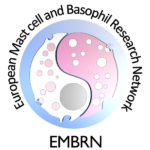What are adaptor proteins?
Proteins with no enzymatic activity that mediate intermolecular interactions through motifs* and /or domains** and are essential in organizing, coordinating and compartmentalizing activated signaling molecules.
*Motif: short sequence of aminoacids
**Domain: conserved part of a given protein sequence and structure that can evolve, function, and exist independently of the rest of the protein chain.
Types of adaptor proteins
TRAPS: Transmembrane adaptor proteins
CAPS: Cytoplasmic adaptor proteins, possessing no hydrophobic transmembrane domain. They are localized free in the cytosol or are associated with the cytoskeleton, membranes and organelles.
Important domains in CAPS
Src-homology 2 SH2: Binds specific phosphotyrosine (pY)-containing motifs in the context of
3 or 6 aminoacids located carboxy terminal to the pY.
Src-homology 3 SH3: Binds proline-rich sequences in a left-handed polyproline type II helix.
Phosphotyrosine binding PTB: Binds pY-containing peptide motifs/Asp-Pro-any aminoacid-pY).
Pleckstrin homology PH: Binds specific phosphoinositides and thus mediate translocation to plasma membrane.
Proline rich PxxP: Aminoacid sequences rich in proline residues able to bind SH3 domains.
ENA/VASP homology domain EVH1: 160-190 aminoacids in lenght. Responsible for F-actin binding.
Expression and function of CAPS in mast cells (Figure 1 and 2)
Cytosolic adaptor proteins are essential for signal propagation from the plasma membrane receptors.
In the case of the IgE high affinity receptor (FcεRI), CAPS such as 3BP2, SLP76, GADS, function to
assemble macromolecular complexes and promote, coordinate and control FceRI–mediated
mast cell responses including degranulation and de novo synthesis of cytokines and eicosanoids (1).
3BP2 (SH3 Binding Protein 2)
3BP2 (85 kDa)
Expression: Abundantly expressed in hematopoietic cells.
Ligands in mast cells: LAT1 (2), Syk (3), PLCγ (3), Lyn (4), Vav, 14-3-3 (5).
Function: Overexpression of SH2 domain of 3BP2 in the rat mast cell line RBL-2H3 inhibits Ca2+ influx and degranulation (2).
Silencing of 3BP2 in human mast cells blocks calcium influx, degranulation and cytokine production (3).
SLP76 (SH2 domain containing leukocyte-specific phosphoprotein 76kDa)
SLP-76 (76 kDa)
Expression: Abundantly expressed in hematopoietic cells.
Ligands in mast cells: GADS (6), Vav, SLAP-130 (7), Grb2 (8).
Function: SLP-76 –null mast cells are defective in degranulation and cytokine secretion (9). The in vivo response is also defective (9).
GADs (Grb2-related adaptor downstream of Shc)
GADS ( 40kDa)
Expression: Abundantly expressed in hematopoietic cells.
Ligands in mast cells: SLP76 (6), LAT 1 (7).
Function: Similar to SLP-76 since recruitment of GADS (via SH2 domain) to the LAT 1 protein complex after FcεRI stimulation is essential
for SLP-76 function (6).
Grb2 (Growth factor receptor–bound protein 2)
Grb2 (25 kDa)
Expression: Ubiquitous.
Ligands in mast cells: SOS, Shc (10), LAT 1 (11), LAT 2 (12), Gab2 (13), SLP-76 (8).
Function: The pathway Grb2-SOS induces MAP kinase activation after FceRI stimulation but no direct evidence of function in mast cells (10).
Shc
Shc (46, 52 kDa)
Expression: Ubiquitous. Two isoforms expressed on mast cells.
Ligands in mast cells: SHIP1 (14), Grb2 (15), Gab2 (13).
Function: Amplifies the signaling of Grb2-SOS activating MAP kinases. Also plays an important role in the negative regulation of FceRI
binding to phosphatase SHIP-1. The phosphatase may compete with Grb2 binding to Shc interfering with SOS recruitment and therefore MAP activation (16).
SLAP-130 (SLP-76 associated protein 130 kDa) (alternative names: ADAP/ Fyb/FynB)
SLAP-130 (130 kDa)
Expression: T and mast cells.
Ligands in mast cells: SLP76 (7), Fyn (19), SKAP55 (18).
Function: In the RBL-2H3 mast cell line overexpression of SLAP-130 increases adhesion to fibronectin and enhances mast cell degranulation (18,19). However ,SLAP-130 deficiency does no alter degranulation nor affect adhesion to fibronectin in vitro. Anaphylaxis is unaltered in SLAP-130 null-mice (21).
Gab2 (Grb2-binding protein 2)
Gab2 (97 kDa)
Expression: Ubiquitous.
Ligands in mast cells: p85 (22), Grb2, Shc (13), PLC-g1, PLC-g2, SHP-2 ( 23), Fyn (24).
Function: Gab2-null mast cells shows impaired degranulation upon FceRI stimulation and are defective in cytokine secretion. Accordingly, Gab2-null mice shows disminished responses in cutaneous and systemic anaphylaxis. Gab2 deficiency causes a defect in PI3K activation (22). Unexpectedly, Gab2 overexpression causes suppression of FceRI signaling possibly through binding to SHP-2 (22,23).
DOK (Downstream of tyrosine kinase)
DOK (62kDa)
Expression: T and mast cells. Different isoforms Dok1, Dok2 and Dok3 in mast cells.
Ligands in mast cells: RasGAP (25), SHIP-1 (26).
Function: Dok1 forms a negative regulatory complex with SHIP-1/RasGAP downregulating PI3K and MAPKinase pathways. The complex was described in mast cells after FceRI and FcgRIIB co-aggregation (26) as well as CD84 triggering (27). Dok1deficiency does not affect mast cell activation, suggesting a possible redundant role of different isoforms expressed (26).
References:
| 1. | Alvarez-Errico, D., Lessmann, E., and Rivera, J. (2009) Adapters in the organization of mast cell signaling. Immunol Rev 232, 195-217 |
| 2. | Sada, K., Miah, S. M., Maeno, K., Kyo, S., Qu, X., and Yamamura, H. (2002) Regulation of FceRI-mediated degranulation by an adaptor protein 3BP2 in rat basophilic leukemia RBL-2H3 cells. Blood 100, 2138-2144 |
| 3. | Ainsua-Enrich, E., Alvarez-Errico, D., Gilfillan, A. M., Picado, C., Sayos, J., Rivera, J., and Martin, M. (2012) The adaptor 3BP2 is required for early and late events in FceRI- signaling in human mast cells. J Immunol 189, 2727-2734 |
| 4. | Maeno, K., Sada, K., Kyo, S., Miah, S. M., Kawauchi-Kamata, K., Qu, X., Shi, Y., and Yamamura, H. (2003) Adaptor protein 3BP2 is a potential ligand of Src homology 2 and 3 domains of Lyn protein-tyrosine kinase. J Biol Chem 278, 24912-24920 |
| 5. | Foucault, I., Liu, Y. C., Bernard, A., and Deckert, M. (2003) The chaperone protein 14-3-3 interacts with 3BP2/SH3BP2 and regulates its adapter function. J Biol Chem 278, 7146-7153 |
| 6. | Silverman, M. A., Shoag, J., Wu, J., and Koretzky, G. A. (2006) Disruption of SLP-76 interaction with Gads inhibits dynamic clustering of SLP-76 and FceRI- signaling in mast cells. Mol Cell Biol 26, 1826-1838 |
| 7. | Kettner, A., Pivniouk, V., Kumar, L., Falet, H., Lee, J. S., Mulligan, R., and Geha, R. S. (2003) Structural requirements of SLP-76 in signaling via the high-affinity immunoglobulin E receptor (Fc epsilon RI) in mast cells. Mol Cell Biol 23, 2395-2406 |
| 8. | Hendricks-Taylor, L. R., Motto, D. G., Zhang, J., Siraganian, R. P., and Koretzky, G. A. (1997) SLP-76 is a substrate of the high affinity IgE receptor-stimulated protein tyrosine kinases in rat basophilic leukemia cells. J Biol Chem 272, 1363-1367 |
| 9. | Pivniouk, V. I., Martin, T. R., Lu-Kuo, J. M., Katz, H. R., Oettgen, H. C., and Geha, R. S. (1999) SLP-76 deficiency impairs signaling via the high-affinity IgE receptor in mast cells. J. Clin Invest 103, 1737-1743 |
| 10. | Turner, H., Reif, K., Rivera, J., and Cantrell, D. A. (1995) Regulation of the adapter molecule Grb2 by the FceRI in the mast cell line RBL2H3. J Biol Chem 270, 9500-9506 |
| 11. | Zhang, W., Trible, R. P., Zhu, M., Liu, S. K., McGlade, C. J., and Samelson, L. E. (2000) Association of Grb2, Gads, and phospholipase C-gamma 1 with phosphorylated LAT tyrosine residues. Effect of LAT tyrosine mutations on T cell angigen receptor-mediated signaling. J Biol Chem 275, 23355-23361 |
| 12. | Zhu, M., Liu, Y., Koonpaew, S., Granillo, O., and Zhang, W. (2004) Positive and negative regulation of FceRI-mediated signaling by the adaptor protein LAB/NTAL. J. Exp Med 200, 991-1000 |
| 13. | Yu, M., Lowell, C. A., Neel, B. G., and Gu, H. (2006) Scaffolding adapter Grb2-associated binder 2 requires Syk to transmit signals from FceRI. J Immunol176, 2421-2429 |
| 14. | Huber, M., Helgason, C. D., Scheid, M. P., Duronio, V., Humphries, R. K., and Krystal, G. (1998) Targeted disruption of SHIP leads to Steel factor-induced degranulation of mast cells. The EMBO J 17, 7311-7319 |
| 15. | Jabril-Cuenod, B., Zhang, C., Scharenberg, A. M., Paolini, R., Numerof, R., Beaven, M. A., and Kinet, J. P. (1996) Syk-dependent phosphorylation of Shc. A potential link between FceRI and the Ras/mitogen-activated protein kinase signaling pathway through SOS and Grb2. J Biol Chem 271, 16268-16272 |
| 16. | Tridandapani, S., Phee, H., Shivakumar, L., Kelley, T. W., and Coggeshall, K. M. (1998) Role of SHIP in FcgRIIb-mediated inhibition of Ras activation in B cells. Mol Immunol 35, 1135-1146 |
| 17. | Nahm, D. H., Tkaczyk, C., Fukuishi, N., Colucci-Guyon, E., Gilfillan, A. M., and Metcalfe, D. D. (2003) Identification of Fyn-binding proteins in MC/9 mast cells using mass spectrometry. Biochem Biophys Res Commun 310, 202-208 |
| 18. | Fujii, Y., Wakahara, S., Nakao, T., Hara, T., Ohtake, H., Komurasaki, T., Kitamura, K., Tatsuno, A., Fujiwara, N., Hozumi, N., Ra, C., Kitamura, D., and Goitsuka, R. (2003) Targeting of MIST to Src-family kinases via SKAP55-SLAP-130 adaptor complex in mast cells. FEBS letters 540, 111-116 |
| 19. | Geng, L., Pfister, S., Kraeft, S. K., and Rudd, C. E. (2001) Adaptor FYB (Fyn-binding protein) regulates integrin-mediated adhesion and mediator release: differential involvement of the FYB SH3 domain. Proc Natl Acad Sci USA 98, 11527-11532 |
| 20. | Geng, L., and Rudd, C. (2001) Adaptor ADAP (adhesion- and degranulation-promoting adaptor protein) regulates beta1 integrin clustering on mast cells. Biochem Biophys Res Commun 289, 1135-1140 |
| 21. | Wu, J. N., Jordan, M. S., Silverman, M. A., Peterson, E. J., and Koretzky, G. A. (2004) Differential requirement for adapter proteins Src homology 2 domain-containing leukocyte phosphoprotein of 76 kDa and adhesion- and degranulation-promoting adapter protein in FceRI signaling and mast cell function. Journal of immunology 172, 6768-6774 |
| 22. | Gu, H., Saito, K., Klaman, L. D., Shen, J., Fleming, T., Wang, Y., Pratt, J. C., Lin, G., Lim, B., Kinet, J. P., and Neel, B. G. (2001) Essential role for Gab2 in the allergic response. Nature 412, 186-190 |
| 23. | Xie, Z. H., Ambudkar, I., and Siraganian, R. P. (2002) The adapter molecule Gab2 regulates FceRI-mediated signal transduction in mast cells. J Immunol 168, 4682-4691 |
| 24. | Parravicini, V., Gadina, M., Kovarova, M., Odom, S., Gonzalez-Espinosa, C., Furumoto, Y., Saitoh, S., Samelson, L. E., O’Shea, J. J., and Rivera, J. (2002) Fyn kinase initiates complementary signals required for IgE-dependent mast cell degranulation. Nature immunology 3, 741-748 |
| 25. | Abramson, J., Rozenblum, G., and Pecht, I. (2003) Dok protein family members are involved in signaling mediated by the type 1 FceRI. Eur J Immunol 33, 85-91 |
| 26. | Ott, V. L., Tamir, I., Niki, M., Pandolfi, P. P., and Cambier, J. C. (2002) Downstream of kinase, p62(dok), is a mediator of Fc gIIB inhibition of signaling. J Immunol 168, 4430-4439 |
| 27. | Oliver-Vila, I., Saborit-Villarroya, I., Engel, P., and Martin, M. (2008) The leukocyte receptor CD84 inhibits FceRI-mediated signaling through homophilic interaction in transfected RBL-2H3 cells. Mol Immunol 45, 2138-2149 |

